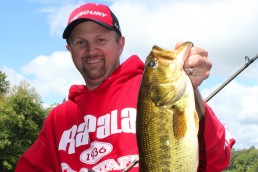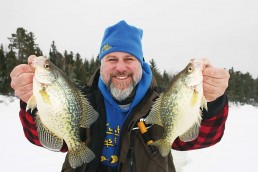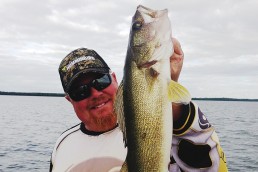Sweet Vibes of the Vibrating Jig: Success is Heard with Noisy Jigs
SHARE THIS POST
“That’s it!? That’s what all the fuss was about?”
Those were the questions running through my head when I first laid hands on a ChatterBait. At first glance, you’ll probably overlook it as another bass jig. But it isn’t. Bladed jigs, vibrating jigs or the ChatterBait, are odd lures that work wonders once they hit water.
The ChatterBait is the original vibrating jig, and was the vision of South Carolina resident Ron Davis in 2003. It remained a local phenomenon there until 2006, and after several wild wins on the American tournaments circuits, the ChatterBait was vaulted into stardom.
Orders overwhelmed Ron’s small business so anglers turned to eBay. The most willing shelled out over $100 per bait and gossip spread even more. Soon, Z-Man Fishing Lures took over manufacturing and the ChatterBait hit the market. Success even brought a wave of copycat baits that made their way into boats.
Over time, the fanfare quieted but not its effectiveness. A hybrid between a swim jig and a spinnerbait, its most distinguishing feature is its hexagonal metal lip. When cranked through the water, it vibrates, releasing a wide wobble and throbbing pulse. Although it doesn’t produce as much flash as a spinnerbait, it does swim much more seductively.
LaSalle, Ont. native Casey Martin, now of New Hope, Ala., is a huge believer in vibrating jigs—he believes he owes his professional fishing career to it. He is the only Canadian to ever win an American national bass tournament.
Martin finds that these baits shine when bass are in cover, in murky water or when fishing pressure is overwhelming.
“ChatterBaits are awesome,” Martin says. “Alone, they’re great and have a wide, erratic swim and produce a lot of vibration. When teamed with a bulky trailer like a Turbo Craw or swimbait, they transform the erratic motion into a more realistic swimming action.”
Martin honed his bass tournament career as a co-angler fishing out of the back of a pro angler’s boat. Casey excelled at fishing behind others and loves the versatility of the ChatterBaits. One of Casey’s most exciting wins was at Lake Champlain along the New York and Vermont state line. Fishing thick weed beds, Casey fired a Green Pumpkin ChatterBait with matching swimbait trailer everywhere his pro angler brought him over the course of the three-day tournament. Martin caught both smallmouths and largemouths in this bait and was able to use it up shallow and in many grass beds that grow in the mid-depths there.
Jimmy Looi, of North York, is another big fan of vibrating jigs. He finds they are super search baits. Patrolling the bass-rich shallows of the Kawarthas or Bay of Quinte is where Looi can be found most summers. The time periods Looi prefers are right after the season opener and again in late August and into September. He finds that largemouths have not yet retreated to the bottom of heavy weeds to sulk from the muggy summer heat.
Jimmy targets largemouth bass along inside grass lines, pads, canes and other shallow cover.
“Shallow for me is 1 to 3 feet of water.” Looi says. “I keep the bait high and move it is quickly with a steady retrieve.”
In late summer and into early autumn, Jimmy targets the grass flats in the mid-depths.
“I look for 8 to 14 feet of water and try to catch them there. These baits are a great alternative to a spinnerbait or crankbait.”
Hunting for active bass demands a quick tempo; this style of bait casts like a bullet and doesn’t wear you out like a big crankbait or spinnerbait. The trick is to always keep feeling the bait thumping.
Jimmy usually targets grass with this bait and is a firm believer in braided fishing line. If the bait fouls, he’ll snap the rod quickly, flicking off any weeds.
Are you enjoying this post?
You can be among the first to get the latest info on where to go, what to use and how to use it!
“It’s easy to tell if the bait is running correctly by feeling its pulse as it swims. Braid slips through the grass better than mono and has the power to dig fish out of cover after it gets bogged down,” he explains.
Typical spinnerbait tackle is a perfect fit. Jimmy prefers a rod just over 7 feet teamed with a reel with a high-spear gear ratio and spooled with 50-pound-test PowerPro braid.
Casey’s outfits are divided into open-water or shallow-cover fishing. For open water, he opts for a 7-foot rod in medium-heavy action with a 6.2:1 baitcasting reel spooled with 17-pound fluorocarbon. In shallow water, where more actuate casts are a must, he’ll switch over to a 6-foot 10-inch rod in the same rod action and reel, but bumps up to 20-pound-test fluorocarbon.
Braided line’s no-stretch qualities are excellent at zipping the bait through thick grass and most love the sensitivity and power braid offers. No-stretch line will work against you while trying to keep wild fish buttoned, especially if a rod doesn’t have a flexible tip. Scale down the rod action and make sure it has some rod flex.
Just like a square-billed crankbait, this bait deflects well off of wood, especially docks posts. As the bait ricochets off cover, its flash and vibration changes, triggering a reflect bite. Call it “bump the stump” or “bang the brush,” it quickly changes in speed, flash and vibration to make bass bite. Most are fearful to fling a bait without a weed guard into heavy cover, but vibrating jigs are tailor-made for it. Make sure you can hit the ten- ring or you’ll be catching more tangles that fish.
One of my first introductions to these baits was fishing in the Bay of Quinte. By midsummer, the shallows were almost fully choked with weeds. Slivers of open water remained, and that’s where we sunk soft plastics. Bites were coming, but the afternoon winds picked up. Chopping through the tangled weeds with the trolling motor in heavy winds was fatiguing, and lack of feel we had just added to our headaches. We decided to raise the trolling motor and drift through the weed beds that crowned several shallow bays, and substituting the subtle plastics for vibrating jigs was necessary to keep the pace brisk. An hour later it became evident that we made a great choice as bass were viciously slamming the baits as we worked them through grass and open water pockets.
One odd distinction with these baits is popular color choices. Standard jig colors dominate compared to the traditional white and chartreuse spinnerbait choices. Green pumpkin, brown, black and blue with splashes of orange, yellow and red, work amazingly well.
Martin is a huge believer in green pumpkin any time he’s fishing up shallow. If he observes perch in the cover, he dyes a few strands of the skirt and matching trailer with orange for a perfect perch imitator.
“One important point to remember is that the trailer has to match the skirt color,” Marin said. “I find it makes the whole bait look more appealing.”
He says keeping the bait and trailer “matchy-matchy” has worked anywhere he fishes.
Don’t abandon white or chartreuse baits, as they have their moments.
Looi is a firm believer in them and so should you. Casey says he finds white and chartreuse more appealing when the bass are munching on baitfish.
Lure sizes range from 1/8 to 3/4 ounce, but 1/2 seems to be the most versatile. Martin prefers 1/2 ounce for most conditions. He finds this size helps keep the bait deeper in the water, even with a speedy retrieve. Casey also recommends the 3/8 and a chunky trailer to add buoyancy and if you want the bait running just below the surface
The hexagonal bladed jig has spawned creative twists. Removing the skirt and replacing it with a swimbait, paddle-tail worm, or larger finesse worm transforms it into something unique. Switching the skirt for a plastic bait is a great alternative when fish get touchy—this modification has been my wife’s secret weapon for years. Teamed up with a large paddle-tail goby bait, she catches limits without much effort.
Every year I try to learn now to fish new lures. Bladed jigs deserve time to be knotted to your line. You’ll be kicking yourself for not trying them sooner.
MWO
SHARE THIS POST
Did you enjoy this post?
You can be among the first to get the latest info on where to go, what to use and how to use it!
Luigi De Rose
Luigi De Rose, has been crafting articles for the last 25 years. Loving anything fishing, especially bass fishing, Luigi has been lucky enough to fish on three continents. Currently, he is the bass editor at Ontario OUT of DOORS magazine and owner of IBASSIN.com, a blog decided to all things bass. His articles have graced the pages of Bassmaster, In-Fisherman and MidWest Outdoors to name a few. When not fishing, you can find him with his two girls and wife in the outdoors.



